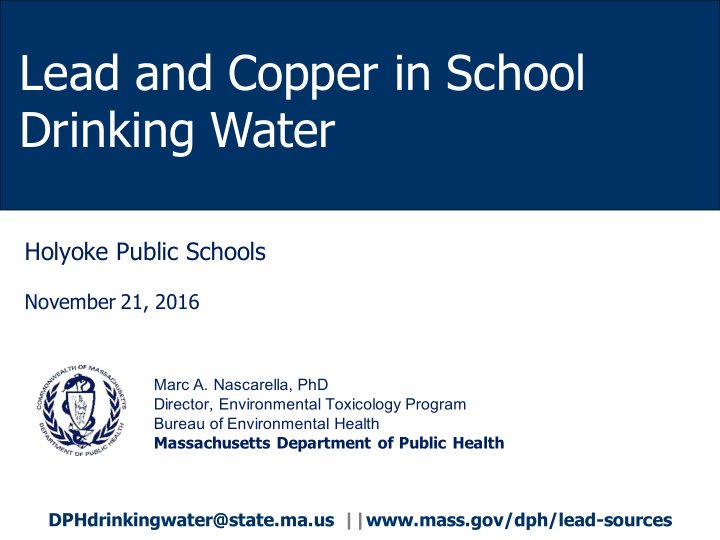



Lead and Copper in School Drinking Water Holyoke Public Schools November 21, 2016 Marc A. Nascarella, PhD Director, Environmental Toxicology Program Bureau of Environmental Health Massachusetts Department of Public Health DPHdrinkingwater@state.ma.us ||www.mass.gov/dph/lead-sources
Why is drinking water being tested at schools? • Surveillance effort to identify lead and copper in drinking water • Samples from water fountains, sinks, and faucets
How does lead and copper get into drinking water? • Drinking water sources in MA are typically free of copper and lead • These contaminants enter water through lead pipes or plumbing with copper and lead parts • Highest levels occur when water stands in pipes for hours or when hot water draws contaminants out of pipes and fixtures
How do lead and copper get into someone’s body? • Low levels are present in food, drinking water, soil, dust, and air • Everyone is exposed to small amounts from these sources • It is not uncommon for individuals to have a low levels of lead in their body
What if levels in the drinking water are high? • Lead levels are considered high if they are over 15 micrograms per liter (µg/L) or parts per billion (ppb) • Copper levels are considered high if they are over 1,300 ppb • Access to water at taps or fountains with high levels should be prevented and alternate sources of water or filters identified • Levels can be reduced by replacing pipes, reducing corrosiveness, flushing, and other methods
How can lead make someone sick? • Lead can affect every organ system in the body • Developing brains of infants, young children, and developing fetuses are at greatest risk • Lead exposure should be reduced as much as possible
How can copper make someone sick? • Unlike lead, copper is essential to good health in small “trace” amounts • We have a natural mechanism to maintain proper levels • High levels cause nausea, vomiting, diarrhea, and stomach cramps • Some individuals, like those with liver disease and Wilson’s disease, have trouble eliminating copper and these individuals are at greatest risk
Is blood testing recommended? • Blood testing is not recommended • It is unlikely that drinking water at schools would cause staff or children to have elevated levels of copper or lead in their blood • The most important thing to do is identify and remove the suspected sources
Blood Lead Testing in Massachusetts • Children are commonly screened for elevated levels of lead • Chile blood lead levels are tested at 9-12 months, ages 2 and 3, and sometimes at age 4, depending on where they live • This approach helps identify lead poisoned children, and eliminate lead sources • If your child has never been screened or you have specific health concerns - you should discuss this with your health care provider Additional Information on blood lead screening is available from the Massachusetts DPH Childhood Lead Poisoning Prevention Program ( 1-800-532-9571 ) or www.mass.gov/dph/clppp
How can I reduce exposure to lead at school? • Let the water run for 1 minute before drinking from fountain or faucet • Use cold water for drinking and cooking • For hot water, heat cold water in the microwave or on stovetop • Obey signs identifying water outlets that are not for drinking • Use cold water to mix up baby formula, and warm formula to serve
Where can I get additional information? www.mass.gov/dph/lead-source
Who can I contact with additional questions? For questions about health effects from potential exposure to lead and copper, you may contact the: Massachusetts Department of Public Health Bureau of Environmental Health (617) 624-5757 DPHdrinkingwater@state.ma.us www.mass.gov/dph/lead-source If you have questions about specific symptoms, or urgent medical questions, you should consult with you healthcare provider. To find an adult specialist in environmental health, your healthcare provider may contact the Association of Occupational and Environmental Clinics (AOEC) Toll Free: (888) 347-AOEC or (888) 347-2632 To reach a pediatric specialist in environmental health, your healthcare provider may contact the Pediatric Environmental Health Specialty Unit (PEHSU) Toll Free: (888) CHILD-14 or (888) 244-5314
Recommend
More recommend